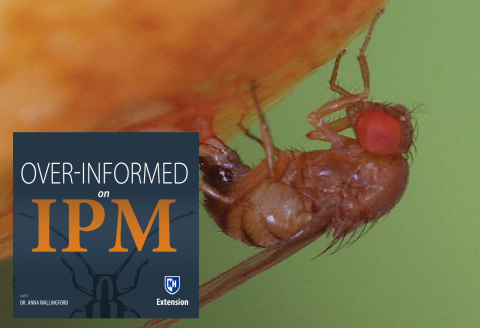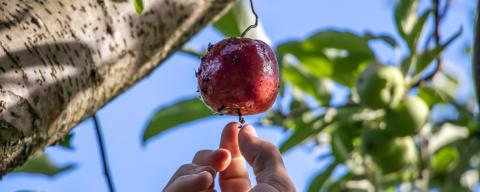Over-informed on IPM - Episode 015: SWD and Blueberry Maggot

Show Notes
Spotted Wing Drosophila IPM Weekly Scouting Reports
Back when I was a master’s student, the Pfeiffer lab had a newly planted field of fall-bearing raspberries to conduct research in. Fall bearing raspberries were the new hot thing back then because they produced fruit on that year’s wood. This is in comparison to traditional summer-bearing raspberries that put out primocanes – these are just vegetative in their first year and become floricanes in their second year. It’s the floricanes that product flowers which are pollinated and become delicious fruit. In traditional raspberries, it’s best to prune out old floricanes at the end of the year to make way for the primocanes, which will produce fruit for your next year. Fall bearing raspberries produce flowers in their first year, so you don’t have to do that tedious task of pruning – you can just mow them down every year. Easy peasy! The only trade off was that you had to wait a little longer for these plants to produce fruit – instead of June or July, fall-bearing raspberries produce fruit in the fall.
I remember Dr. Pfeiffer commenting on how this made for an interesting entomological project because introducing what amounted to a new crop could bring new areas of pest management research. Little did we know what we were in store for with the arrival of spotted-wing drosophila, or SWD! I often think back to those simpler times in a pre-SWD world where small fruit crops in the northeast didn’t have any serious pest problems. For blueberry, you might have had to worry about mummyberry on bad years… maybe the tephritid, blueberry fruit fly…but blueberry fruit fly has one generation so you could potentially mass trap it and even if there was a need to treat it was a one and done situation. This is not the case with SWD.
SWD is a topic that I will likely return to often here but here’s what you need to know:
This fruit fly is invasive, accidentally introduced to the US some time ago. It was first detected in California in 2008 where it was definitely a concern but not as much as you might think, since it’s so hot and dry there and SWD can’t handle hot and dry conditions very well. The first east coast detection was in Florida in 2011 and fruit workers were shocked to see detections all the way up the east coast, all the way up to Canada, in one year. It was unprecedented. Major crop losses were observed in 2012, many growers saw 100% crop loss due to SWD infestation, especially in northeastern areas were many small fruit growers did not use a lot of pesticides. Actually, many of these growers found themselves with a choice between investing in spray equipment and education or bulldozing the crop. Lots of people bulldozed! But many people have found a way to live with this pest.
They call SWD spotted wing drosophila because the males have a very distinctive spot on their wing but that’s not the most interesting thing about this fly. The female has a serrated, heavily sclerotized ovipositor that her native cousins do not have… If that term doesn’t mean anything to you, this essentially means she’s got saws on her lady parts that allow her to cut into the skin of growing fruit and lay her eggs. These eggs hatch and larvae develop in fruit, making them very gross. Sometimes the fruit will drip off the plant and the larvae will pupate in the soil, leading to another new generation of flies who are ready to lay eggs within days.
Best management practice is to protect plants with a broad-spectrum insecticide when the fly is present on your farm. Another particularly diabolical aspect to this pest is that it develops really well in wild hosts, almost any wild plant that produces fruit. This means that new waves of flies will fly into cultivated space so, even though insecticides do a pretty good job at controlling insects that are in those plantings, there’s a new crop of flies entering these spaces on a pretty regular basis. Pruning plants to let light in to plant canopies and cleaning up dropped fruit can help quite a bit but there isn’t much in the way of natural enemies of this invasive pest. So consult your guide, read your labels, and rotate those insecticide classes.
I spoke with one of Maine’s specialists working with wild blueberry about the state of IPM in a post-SWD world:
Lily Calderwood, UMaine
Lily: I’ve heard from a few people that they don’t even like to use the term economic thresholds anymore, that term. But in the case of blueberry maggot fly and SWD, those numbers are really important.
Blueberry maggot fly in the wild blueberry system – and when I say wild blueberry, I mean low bush blueberry. These plants are 6-8” off the ground and they’re grown in these big fields, almost like a corn field or a hay field, but blueberries. So we have these big fields of blueberries and the maggot flies are migrating in from forest edges. A lot of Frank Drummond’s work looked at the behavior of these flies and their flight patterns coming into the field. They’re pretty weak fliers so they actually fly pretty low to the ground and they come directly from the forest edge into the field edge. They don’t skip the edge. They’re not coming from the forest into the center of the field. So he though maybe we could just spray the edge of the field. It worked very well and we’re still using that practice.
The recommendation is to spray your product 25’ from the edge of the forest based on trap numbers. Before you spray, you want to go out and trap. The traps are similar to apple maggot traps but they’re yellow triangles we put out at a rate of one per acre. Once you get 10 total flies per trap on average, that’s your threshold. What we call an economic threshold. Then you can warrant a spray application. Spraying 25’ of the edge.
Transition
Anna: I asked Lily to compare the phenology of blueberry maggot fly to SWD, like what time of year do you see these guys out there?
Lily: Bluberry maggot fly is pest in July in Maine and SWD – well it depends on the year. We’ve been monitoring SWD for 5-10 years now and its variable. Each year is a little bit different. Typically we’ve expecting SWD to arrive in southern Maine in August. Later on, like right at the third or fourth week of our blueberry harvest, we’ll see SWD arrive to the downeast region. This is the furthest north and east we grow blueberries. But last year, in 2018, we actually had SWD arrive to the downeast before it arrived in the southern part of Maine. So that was very confusing!
Anna: So there’s a lot we don’t really understand about this insect yet. There is an army of entomologists working several aspects of this pest’s biology, ecology, and management so stay tuned for more…but I asked Lily to summarize our best approach for blueberries in the northeast:
So you would be monitoring for blueberry maggot and SWD at the same time. If you hit threshold you could do a border application, while you continue to monitor for SWD, which would probably occur later. Then you would want to do the whole field because SWD will spread themselves out more?
Lily: Right. And they’re different traps.
Anna: Which traps are you using in Maine right now?
Lily: We’re using the sugar and yeast trap in the red solo cup right now.
Anna: So monitoring for SWD can be done with stuff you buy at any grocery store. Or you could listen for reports of SWD in your area. George Hamilton posts weekly trap catch data for southern regions of New Hampshire on a weekly basis, so check those numbers on the extension website. Look for “weekly SWD scouting reports” That’s it for now. Thanks to Dr. Calderwood from the University of Maine and special thanks to Brentwood’s favorite son, Jason Lightbown, who wrote and performed our theme music.
Related Resource(s)
Complete Show Episode List
Extension Services & Tools That Help NH Farmers Grow
Newsletters: Choose from our many newsletters for production agriculture
Receive Pest Text Alerts - Text UNHIPM to (866) 645-7010
